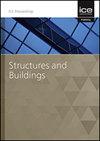Flexural strength of steel girders with perforated web and tubular compression flange
IF 1.4
4区 工程技术
Q3 CONSTRUCTION & BUILDING TECHNOLOGY
Proceedings of the Institution of Civil Engineers-Structures and Buildings
Pub Date : 2023-05-09
DOI:10.1680/jstbu.23.00010
引用次数: 0
Abstract
Lateral torsional buckling, that pronounced for the case of laterally unrestrained compression flange, reduces the moment capacity of steel I-girders. To recover this weakening, the approach is to replace the conventional plate flange with a rectangular tube which has higher lateral stiffness thus valuable against lateral buckling. At the same time, web openings in this section are introduced to enable passing of services but causing strength reduction. Girders with tubular flange plus web openings are yet not discussed in publications. In this paper, FEM is performed to fill this gap studying different web and flange slenderness classifications as well as parameters such as size of web openings, spacing, and location. The results for solid web are found more comparable to EC than AISC, enabling good prediction of the flexural capacity. By introducing web openings, the flexural capacity is reduced by 10%-20%, closer to the higher side for large opening diameters located near the compression flange. The oval shape of the openings has less reduction strength while the square is unfavorable. Tubular flange girders, even if perforated, proves its flexural strength enhancement and considerable reduction of the material than the plate flange girders. This section behaves better regarding the carbon emissions.带孔腹板和管状压缩法兰的钢梁抗弯强度
横向无约束压缩翼缘的侧向扭转屈曲降低了工字梁的弯矩承载力。为了恢复这种弱化,方法是用矩形管取代传统的板翼缘,矩形管具有更高的侧向刚度,因此具有抗侧向屈曲的价值。同时,在该部分引入了web开口,使业务可以通过,但会导致强度降低。管状法兰加腹板开口的梁尚未在出版物中讨论。本文采用有限元法来填补这一空白,研究了不同的腹板和法兰长细度分类以及腹板开口尺寸、间距和位置等参数。实心腹板的计算结果与EC比AISC更具可比性,可以很好地预测抗弯能力。通过引入腹板开口,抗弯能力降低了10%-20%,对于位于压缩法兰附近的大开口直径,抗弯能力更接近高侧。椭圆开口的抗折强度较低,方形开口的抗折强度较低。管式翼缘梁即使穿孔,其抗弯强度也比板式翼缘梁提高,且材料用量显著减少。这部分在碳排放方面表现得更好。
本文章由计算机程序翻译,如有差异,请以英文原文为准。
求助全文
约1分钟内获得全文
求助全文
来源期刊
CiteScore
3.40
自引率
6.20%
发文量
61
审稿时长
12 months
期刊介绍:
Structures and Buildings publishes peer-reviewed papers on the design and construction of civil engineering structures and the applied research associated with such activities. Topics include the design, strength, durability and behaviour of structural components and systems.
Topics covered: energy conservation, people movement within and around buildings, strength and durability of steel and concrete structural components, and the behaviour of building and bridge components and systems

 求助内容:
求助内容: 应助结果提醒方式:
应助结果提醒方式:


